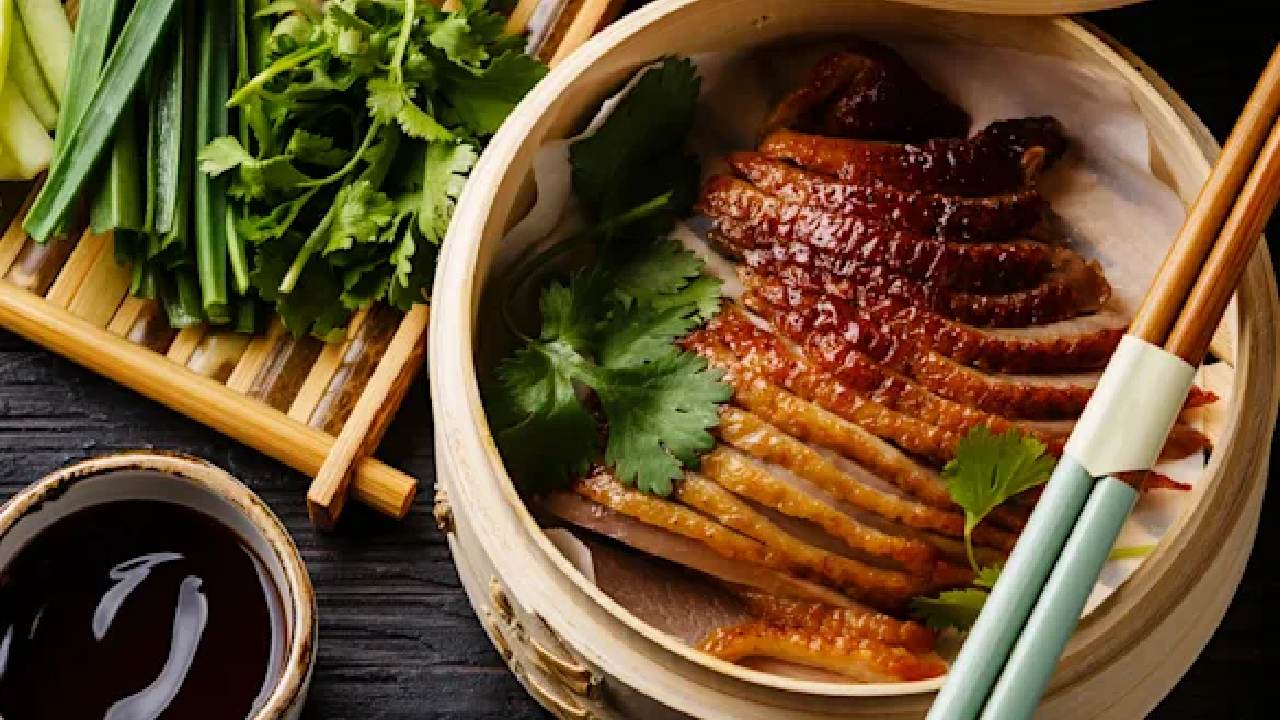
Peking Duck: China’s Iconic Dish That Reflects Culture and Craft
LoveFoodReadyMeals – Among China’s most celebrated dishes, Peking Duck stands as a true symbol of history and craftsmanship. The recipe dates back to the Yuan Dynasty in the 13th century when roasted duck first appeared in the imperial kitchen. Over time, chefs in Beijing perfected the dish, transforming it into a delicacy for emperors. The process required skill and patience, from drying the duck overnight to roasting it over fruitwood flames. Its glossy golden skin and tender meat made it a royal favorite. Eventually, Peking Duck moved from palace banquets to the tables of ordinary people. Today, it represents centuries of Chinese culinary mastery a blend of artistry, precision, and respect for tradition that continues to captivate food lovers around the world.
The Secret to the Perfect Crispy Skin
The true magic of Peking Duck lies in its preparation. Chefs first inflate the duck’s skin with air to separate it from the fat, allowing it to crisp beautifully. Then they coat it with maltose syrup and hang it to dry for nearly a day before roasting. This technique gives the skin its signature crunch and deep amber color. The duck roasts slowly in a brick oven heated by fruitwood, adding a gentle sweetness to the flavor. Every detail counts the timing, the temperature, even the turning of the duck. The result is a dish that tastes as good as it looks. Each bite delivers a satisfying mix of crispness and juiciness that showcases the chef’s mastery and dedication.
“Read More : Luxurious Marble Cake Recipe: Elevate Your Baking With Premium Ingredients”
The Ritual of Eating Peking Duck
Eating Peking Duck is not just a meal it’s a ceremony. Traditionally, chefs carve the duck in front of guests, slicing it into around 100 thin, even pieces. The first few slices, prized for their crisp skin, are often dipped in sugar to highlight their flavor. Next comes the famous wrap: duck meat tucked inside Mandarin pancakes with scallions, cucumber, and hoisin sauce. The mix of textures crunchy skin, soft pancake, and sweet sauce creates a perfect balance. In many restaurants, the remaining meat becomes soup, ensuring that nothing goes to waste. This thoughtful way of dining reflects a deep Chinese value of appreciation and harmony, where every part of a meal is honored and enjoyed together.
From Royal Feast to Global Fame
Once reserved for emperors, Peking Duck has become a worldwide culinary icon. During the Ming Dynasty, it moved beyond the palace walls, attracting nobles and scholars. The dish gained further fame in 1864 when the Quanjude Restaurant opened in Beijing, making it accessible to everyone. Over time, it traveled far beyond China, appearing on menus in cities like London, Paris, and New York. Although some chefs adapt it to local tastes, its essence remains the same crisp skin, tender meat, and elegance in presentation. The dish tells a story of how Chinese cuisine connects people across cultures, preserving its roots while embracing global appreciation.
Cultural Meaning Behind the Dish
In Chinese culture, Peking Duck represents prosperity, unity, and celebration. Its golden-brown color symbolizes good fortune and abundance. Families often serve it during special occasions to bring joy and luck. Beyond its flavor, the dish reflects the philosophy of balance the contrast between crisp skin and soft meat mirrors the harmony of yin and yang. Sharing Peking Duck is a way to strengthen family ties and honor tradition. For many, it’s more than food; it’s a heartfelt experience that celebrates connection and gratitude. In every bite, there’s a taste of history, emotion, and the spirit of togetherness that defines Chinese culture.
“Read More : Exploring Pumpernickel Bread: A Rustic Rye Classic with Deep Flavor”
Modern Twists on a Timeless Classic
While chefs today experiment with new cooking methods, Peking Duck still holds its traditional charm. Some use modern ovens or sous-vide techniques to refine texture, while others innovate with new glazes and flavors. Yet, they all honor the dish’s legacy crisp skin, juicy meat, and patience in preparation. In Beijing, restaurants still carve ducks tableside, keeping the classic ritual alive. Meanwhile, chefs worldwide reinterpret it for modern diners without losing its heart. This blend of innovation and respect keeps Peking Duck timeless. It remains proof that tradition and creativity can thrive side by side, inspiring both old and new generations of food lovers.
A Dish That Connects Heart and Heritage
Ultimately, Peking Duck is more than just a famous meal it’s a bridge between the past and the present. It tells stories of family, history, and pride in craftsmanship. Whether served in a humble Beijing eatery or a luxury restaurant abroad, the dish brings people together in shared appreciation. Each slice carries the warmth of home and the legacy of ancient artistry. For centuries, Peking Duck has delighted kings, travelers, and families alike. Even today, it continues to embody the beauty of Chinese cuisine where food, culture, and emotion come together in perfect harmony.